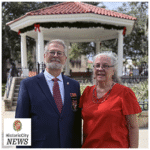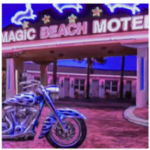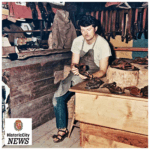 Those who have complained about the potential loss of St Augustine’s iconic “Santa Maria” sign, atop the unremarkable restaurant that bears its name, can sleep better knowing that swashbuckling business tycoon, Pat Croce, won’t pursue further attempts to remodel the aging piece of history that they hold so dear.
Those who have complained about the potential loss of St Augustine’s iconic “Santa Maria” sign, atop the unremarkable restaurant that bears its name, can sleep better knowing that swashbuckling business tycoon, Pat Croce, won’t pursue further attempts to remodel the aging piece of history that they hold so dear.
Historic City News learned last week that St Augustine architect, Les Thomas, got an e-mail from Croce informing him that “it was over”. Thomas, planner Karen Taylor, and her designer, have all been trying to get approval from St Augustine’s Planning and Zoning Board, as well as the city’s Historic Architectural Review Board, to create a planned unit development that would allow Croce to dance between the raindrops of St Augustine’s tightly controlled zoning regulations.
“The Santa Maria sign was originally constructed on the roof of Corbett’s fish house to advertise my parent’s motel along the bayfront,” said 83-year-old Henry M. Whetstone, Sr., who at one time served on the Historic Architectural Review Board. “I climbed up on top of the building myself in the fall of 1953 to connect each letter to a frame and secure it with guywires to keep it from blowing away during a storm.”
Whetstone actually made the sign from steel; he fabricated the individual channel letters and did all of the construction except to blow the single-stroke neon tube that gave the sign its illumination.
The sign read “Casa Marina” which, at that time, was the name of Whetstone’s Bayfront Inn at 138 Avenida Menendez — then known as “Bay Street”. Corbett rented Whetstone the space until the building was sold to its current owners, the Connell family. Whetstone recalled that they named the restaurant “Santa Monica” because it was the least amount of change to the existing “Casa Marina” sign. “They only had to buy more two letters,” Whetstone told Historic City News.
Croce raised a few eyebrows with his Key West style “Raw Bar” sign proposal, beginning with Sue Ellen Agresta, chairman of the Planning and Zoning Board. At their regular meeting held on Tuesday, July 1, Agresta circulated images of the existing signage of Croce’s themed restaurant in Key West. The double entendre and sexual innuendo of a “raw bar” that made revealing use of a woman’s form in the Key West graphics bothered Agresta and others concerned about preserving the family-friendly atmosphere of the city’s history.
The proposed sign would have said, “Half Shell Raw Bar”
“We were beginning to put the numbers together on the project,” architect Thomas told reporters Monday. It is most likely that a protracted battle with adjacent land owners, restaurateurs, citizens groups, and those concerned about Croce’s plan to extend additional dockage further into the Matanzas River, made the project economically unfeasible as an investment for Croce. “Basically, he wanted Hooters on the Water, and we don’t think that’s appropriate,” said one downtown business owner who already has a number of businesses operating along the area.
Discover more from HISTORIC CITY NEWS
Subscribe to get the latest posts sent to your email.





